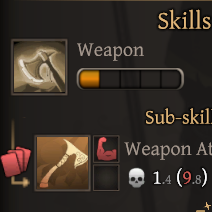Overview
This guide will explain some basic concepts about weapons. How damage is calculated? What is the difference between different weapon types?
Basics
There are 3 types of challenges in Thea 2 where you can use items (weapons):
Physical (Red), Mental (Yellow) and Spiritual (Purple).
Most of basic weapons you will see in early game are used in Fights – a Physical challenge, where you are actually trying to kill opponents and they are trying to kill you. Characters use their weapons and skills to inflict damage. Sounds easy? Not so fast :).
You may notice that same sword equipped by different characters deals different damage!
Let’s look closely at some weapon

This is how we get damage inflicted with this hatched by this character: 11.0 * 2.3 = 25.3
25 is damage – you see in brackets after multiplier. Try to give this weapon to different characters and you’ll see that number in brackets changes (if characters has different Strength).
As you can see – the rule is simple. The higher the multiplier the higher the damage. Higher quality items usually have higher multiplier.
Damage is not everything!
Another important aspect of the skill (weapon) is Delay. All cards act in battle based on the delay. Some weapons are faster than others so you may kill you opponents before they can even hit you.
This where you can see the delay:

Swords and Greatswords

They both melee weapons, which means you’ll need to put your card in FIRST ROW to use it.
The icon explains that:

Swords have a passive ability – Increase Shielding. They increase your shielding in the physical challenges. It is a renewale protection that is expended before hit points.
As this increase is percentage based – it is quite useless for characters without armor. But can be great for your tanks.
One handed swords have the HIGHEST SPEED in the game and the LOWEST DAMAGE multiplier.
One-handed sword can hit only one enemy – the closest one:
Similar to one-handed swords, greatswords provide some shielding, but one-handed sword + shield would provide more.
Greatswords have HIGH SPEED and MEDIUM DAMAGE multiplier
Their main feature is attack pattern:

Note that splash damage (by default) deals 50% of original damage. Some mid-late game weapons can change that.
You can unlock swords in research screen:
Clubs and Mallets

–
These are slow weapons with T-Shape attack.
That makes hammers a good AOE. This is how works:

One-handed clubs have the LOWEST DAMAGE multiplier (just like one-handed swords), but Two-handed mauls have HIGH DAMAGE multiplier.
Their only drawback is speed. They both have SLOW speed.
You can unlock clubs and mallets in research screen to craft them:
Hatchets and Battle Axes

Axes have the HIGHEST DAMAGE and FAST SPEED in the game.
So what is the drawback?
Why not use it all the time?
It all about damage mode. Single melee only.
Playing with axe (especially 2-handed) might require you to have a good armor for protection.
Also it might be a good idea to put your axemen after enemy placed some glass cannon at their front line, so your damage potential won’t be wasted on some meat shield.
Spears and Polearms
Spears have LOW DAMAGE multiplier and MEDIUM SPEED
Polearms have HIGH DAMAGE and LOW SPEED

They have three main advantages over other weapons:



Ranged weapons
There are 3 types of weapons in this category: Bows, Wands and Javelins.
All of them allow you to put card at the SECOND ROW of the battefield – behind your melee characters.
In other aspects those 3 types are quite different.

Unlike basic melee weapons, bows scale with Perception instead of Strength.

Bows have LOWEST DAMAGE multiplier and LOW SPEED.
But cool part about them – you can aim any enemy.
NOTE: Crossbows are no different to Bows from game mechanic point of view. If you’ll try to craft a bow from metal – you’ll get a crossbow.
They also scale with perception, and they have First Strike just like spears.
Their main drawback – they cannot target any enemy.
And here comes fun part!
Wands scale with Destiny
Also you may notice that cards icon is different
If you remember beginning of this guide, I mentioned that there are 3 challenge types in Thea 2 (in fact there are 6, but let’s keep it simple for now).
There are Physical (RED), Mental (YELLOW) and Spiritual (PURPLE).
All other basic weapons we discussed so far can only be used in Physical (RED) challenges. And you’ll see RED card icons next to corresponding skill.
Wands can be used ONLY in YELLOW and PURPLE challenges.
It is very important to understand that your mages wearing basic wands will be useless in RED fights.
Wands have AVERAGE DAMAGE multiplier and the LOW SPEED.
Just like bows, wands are ranged weapons that will allow you to choose you targets sometimes
You can unlock all ranged weapons for crafting in one go

























